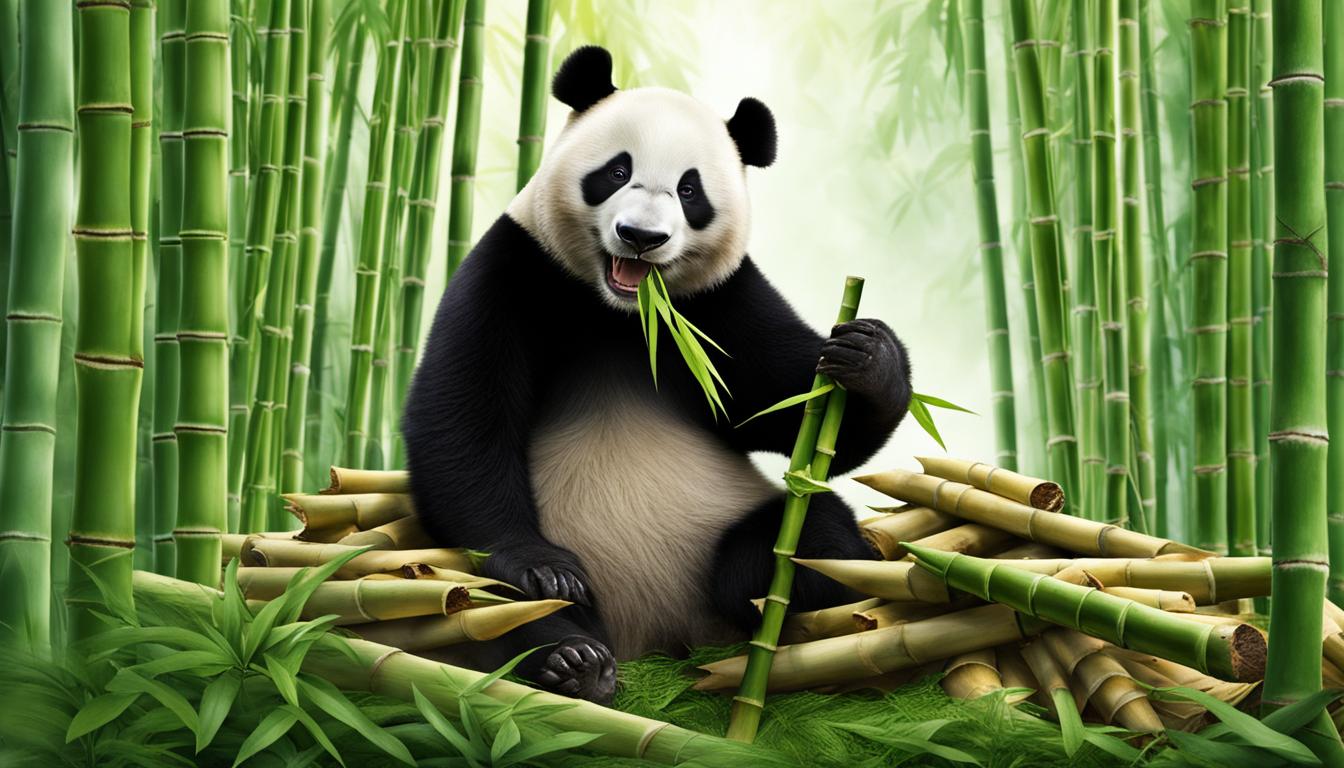Giant pandas, with their iconic black patches and massive paws, have a unique and fascinating diet. They heavily rely on bamboo as their primary source of food. Found primarily in southern central China, these endangered creatures consume an astonishing amount of bamboo every day.
Bamboo makes up the majority of a giant panda’s diet, making it crucial for their survival. In fact, they consume an average of 20 to 40 pounds of bamboo per day. This means that bamboo accounts for approximately 99% of their total diet. While bamboo may have low nutritional value, pandas need to consume large quantities to obtain the nourishment they require.
Despite their limited digestive capabilities, pandas have adapted to specialize in bamboo consumption. Their digestive systems are more similar to those of carnivores, which makes breaking down the cellulose in bamboo challenging. As a result, pandas can only digest about 17% of the bamboo they consume.
Understanding the intricate relationship between pandas and bamboo is crucial for conservation efforts and ensuring the survival of this endangered species. Stay tuned to learn more about the nutritional value of bamboo for pandas, their digestion process, and their foraging behaviors.
The Nutritional Value of Bamboo for Pandas
While bamboo lacks nutrient density, it remains the dietary mainstay for giant pandas. They are able to extract only about 17% of the nutrients from bamboo stalks and foliage. However, bamboo provides a reliable food source for pandas throughout the year. In addition to bamboo, giant pandas occasionally consume bugs, fruit, bulbs, other grasses, carrion, tiny rodents, musk deer fawns, birds, and fish. A diverse diet helps supplement their nutritional needs and ensure survival.
Although pandas consume a large amount of bamboo, their digestive systems are not well-adapted for breaking down cellulose, a component of plant cell walls. They lack the types of bacteria necessary for efficient cellulose degradation, similar to carnivores and omnivores. As a result, pandas can only digest about 17% of the bamboo they consume. This limited digestion efficiency stems from their evolutionary history, as they specialized in bamboo consumption approximately 7 million years ago. The panda’s digestive system is more similar to that of a carnivore rather than a herbivore.
In terms of nutrition, bamboo itself may not provide all the essential nutrients pandas need for their optimal health. However, it offers a consistent and sufficient food source for pandas, allowing them to thrive in their natural habitats. While bamboo lacks in certain nutrients, it is high in fiber and water content, aiding the digestion process. Pandas have adapted to consume large quantities of bamboo to meet their energy needs, ensuring their survival in the challenging environments they inhabit.
| Nutrient | Value in Bamboo |
|---|---|
| Protein | 2% |
| Fat | 0.5% |
| Carbohydrates | 30% |
| Fiber | 28% |
While the nutritional value of bamboo alone might not seem substantial, it is important to remember that pandas have evolved to rely on this resource. Their bodies have adapted to efficiently extract what they need from bamboo, allowing them to thrive and survive in their unique habitat.
Additional Food Sources
In addition to bamboo, pandas occasionally consume other food sources to supplement their nutritional needs. This includes bugs, fruit, bulbs, other grasses, carrion, tiny rodents, musk deer fawns, birds, and fish. These additional food sources help provide variety in their diet and ensure that they receive essential nutrients that may be lacking in bamboo alone.
Pandas have adapted to consume large quantities of bamboo to meet their energy needs, ensuring their survival in the challenging environments they inhabit.
Panda Digestion and Bamboo Fiber
When it comes to the giant panda’s dietary habits, bamboo takes center stage. However, their digestive systems are not well-equipped to break down cellulose, a crucial component of plant cell walls. Unlike herbivores that rely on specialized gut bacteria to efficiently process cellulose, pandas, similar to carnivores, lack these essential microbes. As a result, they can only digest approximately 17% of the bamboo they consume, leaving the remaining fiber undigested.
This limited digestion efficiency is a consequence of their evolutionary history. Around 7 million years ago, pandas specialized in consuming bamboo, altering their digestive system to cope with the challenges of extracting nutrients from this fibrous plant. While their gut anatomy and physiology resemble that of carnivores, their diet primarily consists of bamboo.
Despite their relatively low nutrient density, bamboo remains a vital food source for pandas throughout the year. It provides a consistent and abundant supply of sustenance, allowing the pandas to maintain their energy needs. In addition to bamboo, giant pandas occasionally supplement their diet with other foods, such as fruits, bulbs, grasses, carrion, small rodents, and even fish. This diverse diet helps fulfill their nutritional requirements and ensures their survival in the wild.
Table: Digestion Comparison between Pandas and Herbivores
| Pandas | Herbivores | |
|---|---|---|
| Cellulose Digestion | Limited due to lack of specialized gut bacteria | Efficient digestion facilitated by specialized gut bacteria |
| Digestion Efficiency | Approximately 17% | Varies based on species, but generally higher than pandas |
| Primary Food Source | Bamboo | Grasses, plants, leaves, and other vegetation |
While pandas have adapted to survive on a bamboo-centric diet, their digestive system’s limitations underscore the importance of conserving bamboo habitats. Preservation efforts are crucial in ensuring the survival of these beloved creatures as they continue to depend on bamboo forests for their nourishment and survival.

Bamboo Diet and Foraging Behavior
Giant pandas exhibit unique foraging behaviors and have specific dietary preferences when it comes to bamboo. They consume approximately 12-15 kilograms (26-33 pounds) of bamboo roots, shoots, and leaves daily. They favor shoots, which are highly nutritious and have low fiber content. Young leaves are also consumed due to their lower fiber content compared to older leaves. Pandas can even eat up to 38 kilograms (84 pounds) of “new” bamboo shoots when available. Access to an abundant supply of quality bamboo, particularly during the late winter and early spring, is crucial for sustaining wild panda populations.
To understand the foraging behavior of giant pandas, a closer look at their bamboo diet is necessary. Pandas are selective eaters and often choose certain species of bamboo over others. They have a preference for bamboo with specific nutrient profiles, such as higher protein content and lower fiber content. The availability of different bamboo species and the seasonal variations in nutrient composition can play a role in determining a panda’s foraging patterns.
In addition to their dietary preferences, the foraging behavior of giant pandas is also influenced by factors such as competition and habitat fragmentation. They tend to avoid areas with a high density of other pandas as it can lead to resource depletion. Human encroachment and habitat loss have significantly impacted the availability of bamboo forests, forcing pandas to adapt their foraging behavior and rely on smaller, fragmented patches of bamboo. This change in habitat structure and food availability has implications for the long-term survival of the species.
The Role of Bamboo Availability in Panda Conservation
Ensuring the availability of suitable bamboo habitats is crucial for the conservation of giant pandas. Efforts are being made to protect and restore bamboo forests, create corridors between fragmented patches, and promote sustainable land use practices. These actions not only benefit pandas but also contribute to the overall conservation of biodiversity in the region.
| Bamboo Species | Nutritional Content | Preferred by Pandas? |
|---|---|---|
| Species A | Higher protein, lower fiber | Yes |
| Species B | Lower protein, higher fiber | No |
| Species C | Medium protein, medium fiber | Yes |
Understanding the intricate relationship between giant pandas and their bamboo diet is essential for their conservation. By preserving and restoring bamboo habitats, we can secure a sustainable food source for these iconic animals and ensure their long-term survival. It is vital that we continue to study and monitor their foraging behavior and adapt conservation strategies accordingly.
Conclusion
The panda bamboo diet is paramount to the life of a giant panda, comprising nearly 99% of their daily food intake. Despite bamboo’s limited nutritional value, pandas have adapted to consume large quantities to meet their energy needs and ensure their survival. Their digestive systems, although resembling those of carnivores, have evolved to specialize in bamboo consumption.
Understanding the intricate relationship between pandas and bamboo is crucial for conservation efforts and the preservation of this endangered species. By comprehending the panda’s dietary preferences and digestive limitations, we can better develop effective panda diet plans and ensure their nutritional needs are met.
Conserving the bamboo forests that serve as the pandas’ habitat is vital. Access to an abundant supply of quality bamboo, especially during the late winter and early spring, is crucial for sustaining wild panda populations. By protecting and restoring their natural habitats, we can help provide the necessary resources for these remarkable creatures.
Does the Diet of Giant Panda Cubs Differ from Adult Pandas?
Yes, the diet of giant panda cubs differs from adult pandas. While adult pandas primarily eat bamboo, panda cubs start by nursing from their mothers and gradually transition to bamboo as they grow. This transition is an important part of giant panda cub development and helps them develop the ability to digest bamboo.
FAQ
How much bamboo do giant pandas consume daily?
Giant pandas consume an average of 20 to 40 pounds of bamboo per day.
What is the nutritional value of bamboo for pandas?
Bamboo has low nutritional value for pandas, but it provides a reliable food source throughout the year.
How efficient are pandas at digesting bamboo?
Pandas can only digest about 17% of the bamboo they consume due to their digestive system’s limited adaptation for breaking down cellulose.
Do giant pandas eat anything other than bamboo?
Yes, pandas occasionally consume bugs, fruit, bulbs, other grasses, carrion, tiny rodents, musk deer fawns, birds, and fish to supplement their diet.
Why are pandas specialized in bamboo consumption?
Pandas specialized in bamboo consumption approximately 7 million years ago, and their digestive system is more similar to that of a carnivore rather than a herbivore.
How much bamboo do pandas prefer to eat?
Pandas consume approximately 12-15 kilograms (26-33 pounds) of bamboo roots, shoots, and leaves daily, with a preference for shoots and young leaves due to their higher nutrient content.
Is access to quality bamboo important for wild panda populations?
Yes, access to an abundant supply of quality bamboo, particularly during the late winter and early spring, is crucial for sustaining wild panda populations.
Why is understanding the relationship between pandas and bamboo important?
Understanding the intricate relationship between pandas and bamboo is vital for conservation efforts and ensuring the survival of this endangered species.











